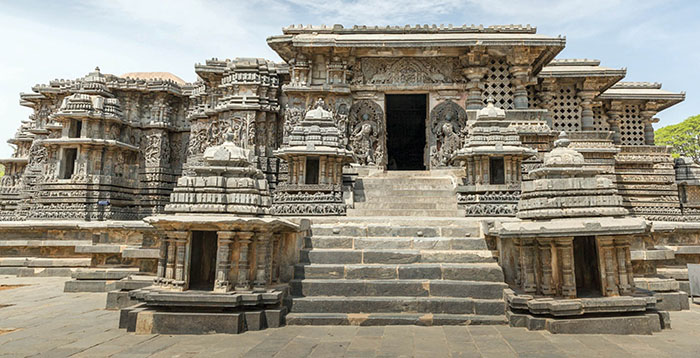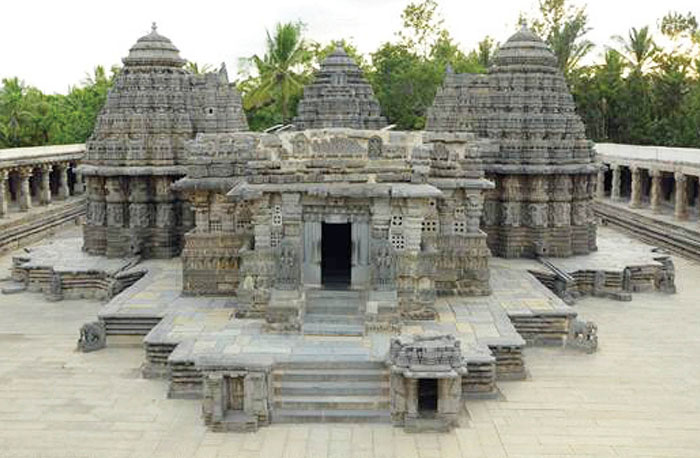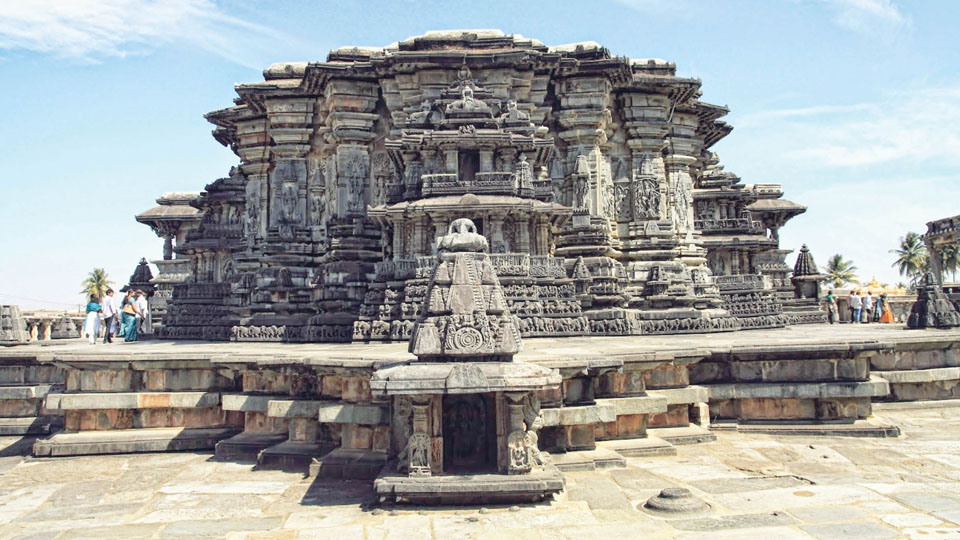Chennakeshava Temple at Belur, Hassan; Hoysaleswara Temple at Halebeedu, Hassan; Keshava Temple at Somnathpur, Mysuru
Mysore/Mysuru: The unique architectural marvels of Karnataka, the 12th century Hoysala era Temples of Belur and Halebeedu in Hassan and Somnathpur in Mysuru districts, were bestowed with the prestigious United Nations Educational, Scientific and Cultural Organisation (UNESCO) World Heritage Site designation.
This is the 42nd addition of India to the heritage list and the fourth in Karnataka.
The ‘Sacred Ensembles of the Hoysalas’, often hailed as ‘Poetry carved in Stone’ on a global scale, had been recommended by the Ministry of Culture in India as the country’s latest nomination for consideration as a World Heritage Site for the year 2022-23.
During the 45th Session of the World Heritage Committee of UNESCO, held in Riyadh, Saudi Arabia on Monday (Sept. 18), India’s proposal for the ‘Sacred Ensembles of the Hoysalas’ was met with unanimous approval. The announcement comes after Shantiniketan in West Bengal received UNESCO world heritage status on Sunday (Sept. 17).

This esteemed recognition added three magnificent temples to the list of World Heritage Sites: the Chennakeshava Temple at Belur, the Hoysaleswara Temple in Halebeedu in Hassan district and the Keshava Temple at Somnathpur in Mysuru district. The Somnathpur Temple is located at a distance of 35 kilometres from Mysuru and the structure is a paradise for art connoisseurs.
In fact, the ‘Sacred Ensembles of the Hoysalas’ have been on UNESCO’s tentative list since April 15, 2014 and represent one of the highest points of human creative genius and stand testimony to the rich historical and cultural heritage of our country.
Among the nations who supported India’s bid for listing of Hoysala Temples in Karnataka as UNESCO heritage site are Japan, Nigeria, Oman, Greece, Italy, Russia, Ethiopia, Zambia, South Africa, Qatar, Mali, Saint Vincent and the Grenadines, Belgium, Argentina, Mexico, Saudi Arabia and Thailand.
UNESCO World Heritage Committee recognised the cultural significance and historical importance of these temples and through a vote arrived at the decision to add the site to the list.
India’s UNESCO rep congratulates
India’s Permanent Representative to UNESCO, Vishal V. Sharma, expressing gratitude to the World Heritage Committee said, “Chennakeshava in the Kannada language means good or benevolent Krishna. These monuments are extraordinary experiences of spiritual purpose and vehicles of spiritual practice and attainment. Set in the foothills of the hilly and forested terrain of Western Ghats of India on sites of enduring sanctity.”
“The stone sculptures and carvings are full of cultural iconography and depiction of the stories from ancient scriptures of India like the Ramayana, Mahabharata and the Srimad Bhagavatham. I conclude Mr. Chair by saying a line in Kannada language congratulating the people of India ‘Naanu Abhinandisuthene Bharatha Janagalige’ Bharat Mata ki Jai,” he said.
It may be recalled here that on Sept. 16, 2022, a team from UNESCO visited the 13th century Chennakeshava Temple at Somnathpur. The team, headed by Tiang Kian Boon, an expert from the International Commission on Monuments and Sites (ICOMOS), also visited the other Hoysala Temples at Belur and Halebeedu before coming to Somnathpur.
Tiang Kian Boon was briefed regarding the architecture of the Temple and the sculptures. He was apprised of its salient features by former Chairperson of Infosys Foundation Sudha Murty who has been actively involved in conservation efforts of heritage Temples and Kalyanis in Karnataka. The then Mysuru Deputy Commissioner (DC) Dr. Bagadi Gautham translated the local residents’ views in Kannada to English.
The dossier for final submission was prepared by the Bengaluru Chapter of Indian National Trust for Art and Cultural Heritage (INTACH) for the Department of Archaeology Museums and Heritage and Department of Tourism with support from the Archaeological Survey of India.

Never seen before or since: UNESCO
Recognising the Hoysala artists and architects who built these masterpieces of a kind never seen before or since, UNESCO, in a statement, said that this serial property encompasses the three most representative examples of Hoysala-style temple complexes in southern India, dating from the 12th to 13th centuries. “The Hoysala style was created through careful selection of contemporary temple features and those from the past to create a different identity from neighbouring kingdoms.”
The global cultural organisation said that the shrines are characterised by hyper-real sculptures and stone carvings that cover the entire architectural surface, a circumambulatory platform, a large-scale sculptural gallery, a multi-tiered frieze, and sculptures of the Sala legend. “The excellence of the sculptural art underpins the artistic achievement of these temple complexes, which represent a significant stage in the historical development of Hindu temple architecture,” the statement added.
PM Modi congratulates
More pride for India! The magnificent Sacred Ensembles of the Hoysalas have been inscribed on the UNESCO World Heritage List. The timeless beauty and intricate details of the Hoysala Temples are a testament to India’s rich cultural heritage and the exceptional craftsmanship of our ancestors.” — Narendra Modi, Prime Minister
Local economy will thrive
This is India’s and Karnataka’s proud moment. We have finally got it though the recognition was pending for a long time. It will boost tourism in the region and whoever visits the Mysore Palace will also visit Somnathpur, Belur and Halebeedu. The task ahead of us is to provide basic facilities for tourists including travel and accommodation. Though we cannot indulge in any sort of development at Somnathpur due to its world heritage site status, the local economy will thrive beyond the Temple premises and the Mysuru region will be on every foreign tourist’s itinerary.” — A. Devaraju, Commissioner, Department of Archaeology, Museums and Heritage








Recent Comments